Narthaki

News

Info

Featured

 |
  |
Dinanath Pathy: a Sutra tribute to a Beacon of Art - Ramli Ibrahim e-mail: ramlii@hotmail.com September 11, 2016 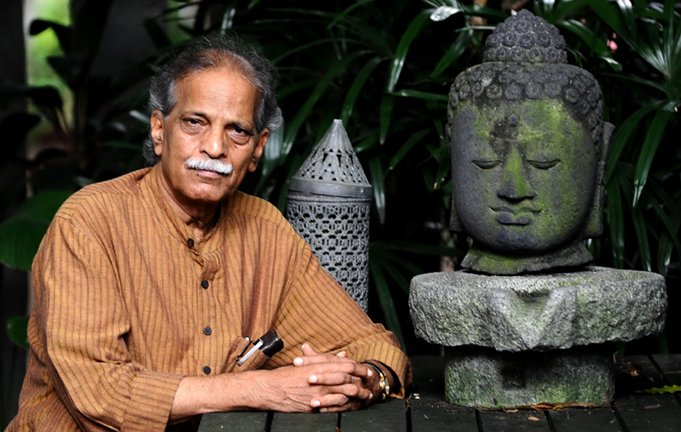
Dinanath Pathy (1942 - 2016)
Photo: A. Prathap (Sutra House 2015) The news of Dr Dinanath Pathy's demise on the morning of 29 August 2016 came as a double-whammy shock during my breakfast in Bali, literally minutes after I had learnt of the death of another icon, the Australian-Balinese architect, Made Vijaya. I had just spoken of Pathy's article in Quintessential Sutra during its Bali book release, just the previous day. I had alluded to Pathy's connection with Bali - how he was the visualiser of the Kalinga-Bali Yatra (1992) mooted by the former Chief Minister of Odisha, the late Biju Patnaik. My speech had emphasised the continuity of Malaysia-Bali-Odisha connection till the present day. Pathy, who had not been to Bali since, together with artist Lekhasri Samantsinghar and her husband Bijay, had once again travelled to Bali in August 2013, with me as guide. We had a splendid time. Many anecdotes of that landmark Bali-Odisha cultural mission were recounted by Pathy and many jig-saw pieces put in perspective. Pathy's untimely death was a great blow especially when he was supposed to launch in Bhubaneswar, the Ila Panda Centre of Arts (IPCA) Artist Conclave that very morning! How could fate have dealt such a devastating blow to his brainchild project, which would have meant so much to the Odiyan artists' fraternity? We had kept in touch with each other with regard to the progress of this project which Pathy had also discussed during his last collaborative effort with Sutra in Kuala Lumpur - Amorous Delight - last July. Though Pathy claimed that he had seen me perform much earlier in Odisha when he was with the late Odissi guru Debaprasad Das, I was only introduced to him properly in the late 90's, when he was invited by the young guru Gajendra Panda, to be guest of honour at Sutra's Odissi performance in FICCI auditorium, New Delhi. The legendary dancer, the late Indrani Rehman, who had taken me under her wings, was also present. Pathy was then the Secretary General of Central Lalit Kala Akademi, New Delhi. Later, I became interested in the concept of his work Interface, which he was collaborating with Gajendra. The work explored the continuum of the tribal, folk and classical in odissi, as also propounded by Debaprasad. Ever since Debuji's demise, I was creatively associated with Gajendra, commissioning from him new repertoire for Sutra. 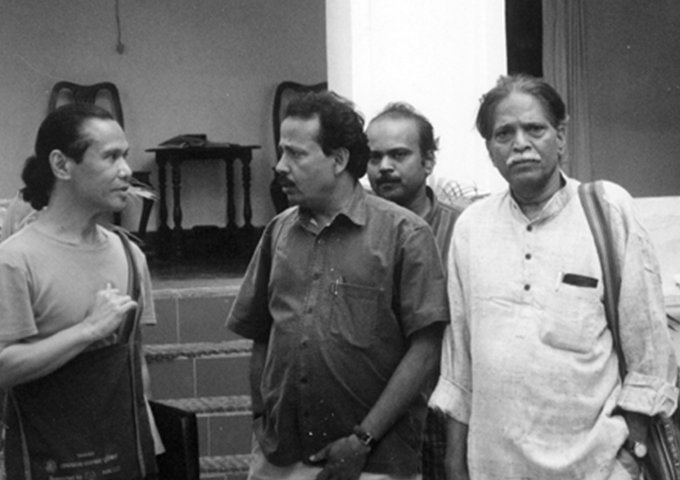
Dinanath Pathy with Rami Ibrahim, artist Ramahari Jena and scholar-writer Soubhagya Pathy at 'Z Hotel', Puri (2008)
Photo: Sivarajah Natarajan Over the course of many performances in Bhubaneswar, I was introduced to his scholar-writer son, Soubhagya Pathy and artist Ramahari Jena. The latter was devoted to him and was genuinely concerned for his wellbeing. Soon, I came in the fold of the creative aura of Pathy's household. He had many students also staying in the compound. Eminent artists, scholars and writers came and went through his door. If I were travelling alone in Odisha, I would stay at Avanti, Pathy's Bhimatangi home. The room where I stayed was a like a library, a dark and mysterious den, covered wall to wall with rare art books. Pathy's house was replete with fascinating posters of exhibitions from Reitberg Museum (Zurich), animal and theatre masks and, of course, his amazingly evocative paintings. My endearing memories of Pathy were the crisp cool winter evenings of engaging conversations over cups of 'chai' at his root-top patio. 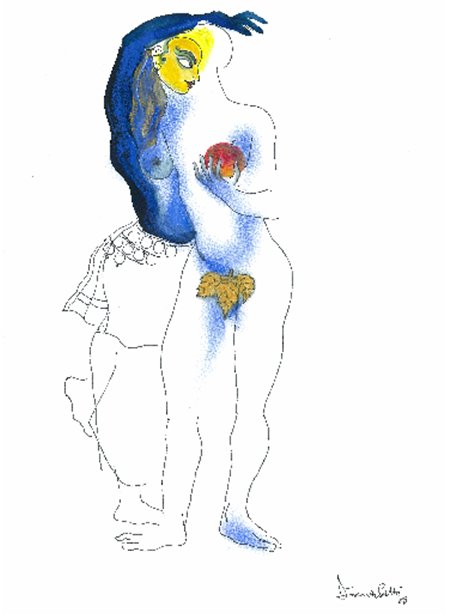 Adam and Eve, watercolor on paper, 37 cm X 27 cm, 2008 drawing by Dinanath Pathy Apart from being Odisha's modernist visual artist of stature, Dinanath Pathy was also a scholar who possessed consummate knowledge of the literary, visual and performing arts of Odisha. His was not mere academic knowledge but the full spectrum of the past and present history of his subject from which he was able to envisage its future potential. A true specialist, he was a man who had thought of his subject in its entirety. Pathy also possessed a full grasp of western art history, its biased orientalist attitudes and its complex relationship in the making of contemporary modern art of India. Therefore, he was able to contextualise his subject within the larger perspectives of global trends. He spoke his mind. He had opinions but was not opinionated. His vision came to him like a visvarupa of life superimposed in collaged images of multi-layered realities, jostling for attention, very much like his own paintings. Be assured that when he delivered a dictum he had already checked and counter-checked for the larger statement of the Truth. So profound was this vision and impression, that Pathy sometimes gave seemingly conflicting impressions and statements. He had arrived at his enigmatic conclusion sometimes without having explained the tedious and intricate manner of the 'whys' and 'hows' by which he had arrived at the conclusion. I had found this disconcerting at first but having understood his thought process and thread of reasoning, I found it valid and insightful. 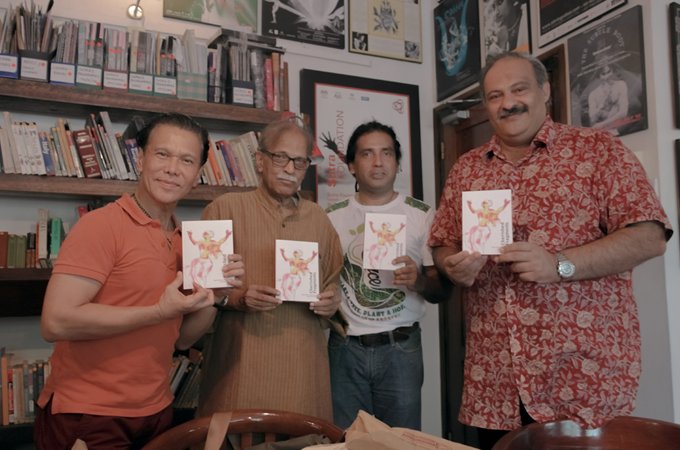 Book release of Cherished Fragment by Dinanath Pathy at Sutra Library (2014) Ramli Ibrahim, Dinanath Pathy, Sivarajah Natarajan and Lalit Verma (Aurodhan, Pondicherry) Photo: Abtin Javid But, how did a boy from a small village town of Digapahandi, Ganjam, who started as a young painter of theatrical curtains, manage to become this charismatic visionary art-giant, possessing such Universalist world-view? It was a fascinating enigma, which kept bugging me. I sensed, that somehow, gleaning through his reminiscences, that his association with the Swiss scholar, Dr Eberhard Fischer over such a significant period of time, had something to do with this. The spell of collaborating with this very disciplined, meticulous and distinguished intellectual, must have rubbed on him a strong sense of ethics and purpose, apart from knowledge itself. In many ways poles apart, the two Swiss-Odiyan figures (Fischer- the cerebral, and Pathy-the emotional), synonymous to Apollonian-Dionysius archetypes, must have made strange bedfellows indeed! (However, Pathy's working table was always perfectly equipped, his bed prepared; he was always immaculately dressed; the regular writing of his diary was testimony of an artist who was well organised and supremely disciplined!) Swiss 'order' must have won and prevailed… I was privileged to be present in many of his cultural excursions - the major ones being ventures to towns of Ganjam districts including visits to the Government College of Art and Crafts, Khallicote, and the incredibly beautiful Nirmaljhar Vishnu Temple nearby; as special guest during the Chaitra Parva Festival of Mayurbhanj Chhau at Baripada; the workshop of Sakhinata dancers at Batakumarada (Berhampur) and our most recent tribal sojourn at Agragamee (Kashinapur), meeting its dynamic director Achyut Das and wife Vidhya. During all these trips, there would always be a get-together; a gathering of young and old where education and cultural issues were discussed. There were always renewals of past ties, exchanges of camaraderie shared over meals. Throughout, I sense the familiarity and love of the people for Pathy and the mission he had spearheaded. He had been with them in their initial struggles, mapping their infrastructure and paths for them. He was the beacon that lit their cause. 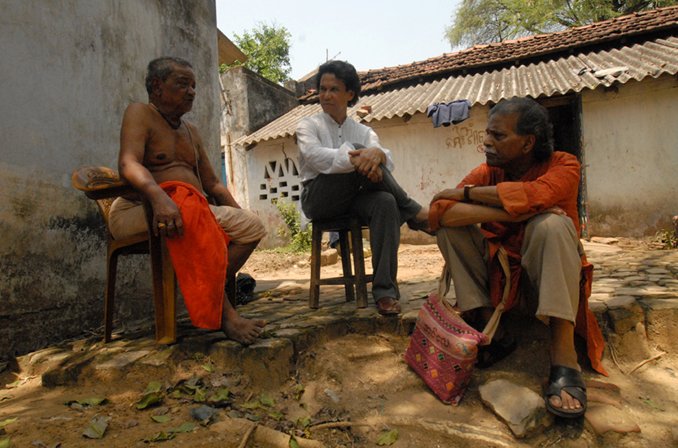 Dinanath Pathy, Ramli Ibrahim with legendary Mayurbhang Chhau dancer, the late Shrihari Nayak at his home in Baripada (2007) Photo by: Sivarajah Natarajan Pathy's nostalgic book The Drawing Master of Digapahandi told the story of his growing up in a village surrounded by people with colorful and eccentric personalities, each secure in his own skin and absolutely sure of their special place in life and reason for living. One cannot help but feel Pathy's sad homesickness and melancholic loss of the once rich life and culture, which had molded his young days. He loathed the pervasive and distasteful triumph of vulgarity that the supposed modernity had brought to Digapahandi. He could hardly recognise when he returned, the landmarks of his village, which he had once lived in and loved. Where Odissi was concerned, Pathy's belief in the unique contribution of the pioneer Odissi guru, the late Debaprasad Das, was unquestionable. It found a platform in ANGARAG - Guru Debaprasad Dance Institute, of which he was chairman and Soubhagya Pathy, the editor. ANGARAG, a journal published bi-yearly became Odisha's independent voice and window to the national and international world of the performing and visual arts. ANGARAG, besides providing readers with amazingly varied articles and photographs, also hosted many interesting performances. The attractively designed journal was always full of surprises. The subject matter of the articles, out of the box, frequently alluded to the East-West karmic culture links. The content often reaffirmed the dictum that nothing exists in a vacuum. Dinanath Pathy is regarded among the most prolific of Odiyan writers, publishing an extraordinary body of essays, articles, novels, short stories and journals on diverse subjects. Among these, without doubt, Rethinking Odissi, a strongly revisionist and critical book on Odissi, which discusses exhaustively its checkered path during the trek of its reconstruction, remains Pathy's most incisive and powerful publication. In this contribution to Odissi (and thus to Indian performing arts), which is Odisha's major international cultural export, the processes of achieving its iconic status are thoroughly dissected, analysed and reviewed. Pathy was directly implicated in a controversy involving Sutra, in Odisha (2005) over the non-wearing of ordni (the sash covering the shoulder) by its dancers. Rethinking Odissi was thus catalyzed by the debate over the underlying issue of what is auchitya (correctitude, propriety) within the specific context of aharya (costume). However, the polemic eventually took on the greater discussion of what exactly is auchitya. The process of delving for the Truth of the Matter, was like the churning of the ocean for amrita. Other aberrations and half-truths perpetrated in legitimizing Odissi were scrutinized, examined and exposed. The book became the proverbial 'spanner' thrown into the romanticized and puritanical hypocrisy surrounding the course of reconstructing Odissi's idealised image, in particular, those espoused by the Jayantika movement. Dinanath Pathy was instrumental in introducing many visual artists of Odisha to Malaysia. Works of Dr JP Das, Ramahari Jena, Kishore Sahoo, Lekhasri Samantsinghar, Jyotiranjan Swain, Soubhagya Pathy, Dilip Tripathy, Arun Jena, Gopal Krushna Rath among others have become known in Kuala Lumpur. Pathy together with Sivarajah Natarajan, Sutra's resident lighting designer and Trustee, were the co-curators for Stirring Odissi, The Exhibition - a major visual arts showcase held at the Petronas Gallery, Twin Towers, in conjunction with the large scale Stirring Odissi, Odissi Festival (2008) which brought in almost 120 strong artists to Kuala Lumpur. The massive combined visual art exposition of more than forty-five artists from Malaysia and India, who presented their creative outpourings inspired by Odissi, was an artistic coup of the first order. A seminar, which discussed the topic of 'Preparing Odissi for the Twenty-First Century' was attended by the major dance critics of Odissi such as Leela Venkataraman, Shanta Serbjeet Singh, Dr Sunil Kothari, Ashish Khokar, Soubhagya Pathy in the presence of other distinguished performing arts scholars from Malaysia. Pathy had catalyzed and integrated not only his capacity as a visual artist but also his role as curator, stage designer, librettist, writer, research consultant and advisor. Pathy contributed a strong article in Sutra's new pictorial book Quintessential Sutra where his paintings and drawings are also featured. Besides curating many exhibitions and presenting his paintings and drawings with Sutra Gallery, it was Pathy's conceptual contribution to some of Sutra's major dance productions, which had enriched us. His predilection to work in dance-theatre was hardly surprising, as after all, Pathy was first and foremost a 'theatre-man'. He was initiated in visual arts through his association with folk theatre. It came as no surprise that one of his major contributions was in integrating the visual and performing arts as two complementary and related genres. 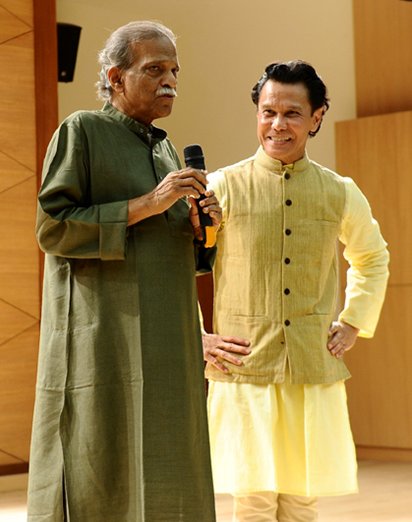 At Malaysian High Commission, Chanakyapuri, New Delhi during Quintessential Sutra book release (April 2016). Photo: A. Prathap It was amazing that the last two years of his life saw outbursts of Pathy's creative energy with Sutra. GANJAM, a large scale Sutra collaboration together with Guru Gajendra Panda, relied strongly on his input. The production featured a large scale LED screen backdrop with projected images created by Pathy together with Sivarajah Natarajan. Pathy was clearly excited working closely with Sutra's web-master Abtin Javid. He saw his drawings and design took on a monumentality as they became a crucial part of the theatre design. GANJAM had its world premiere in Kuala Lumpur at the prestigious Istana Budaya (2015); a second season ensued with a brief north-Malaysia tour and it was eventually premiered in New Delhi (Kamani Auditorium), Bhubaneswar (Rabindra Mandap) and even made it to Rourkela and Berhampur during the scorching heat of summer. 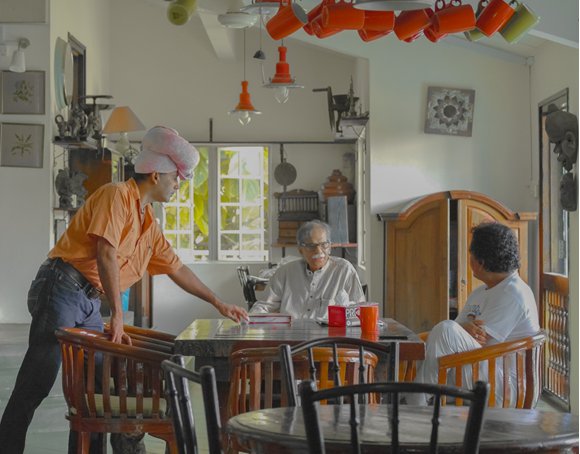 Discussion over breakfast of GANJAM at Sutra kitchen (2015) Sivarajah Natarajan, Dinanath Pathy & Gajendra Panda. Photo: Abtin Javid 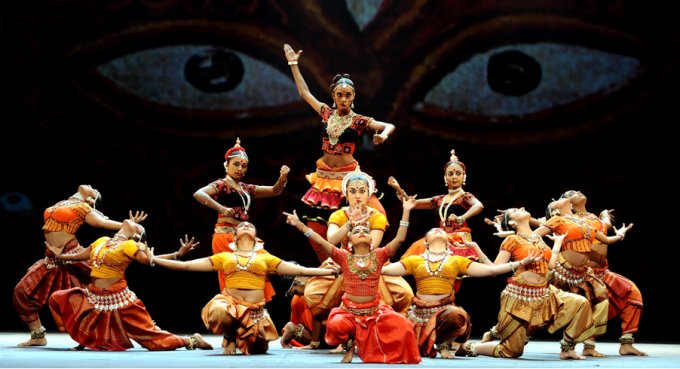 Sutra Dancers in GANJAM (Yogini-Moksha) with background by Dinanath Pathy Photo: A. Prathap, Istana Budaya, Malaysia. (2015) I was also privileged to see Pathy working hard on his exhibition of paintings "I am from Ganjam & so are the Images" held in conjunction with the world premiere. The paintings were based on the village temple murals in Ganjam which he once had helped renovate. Painted in a strong folk style, the paintings underscored the stark folk element in the painting of village temple murals. (This particular renovation was documented with Swiss scholar, Dr Eberhard Fischer in a journal published by Rietberg Museum.) 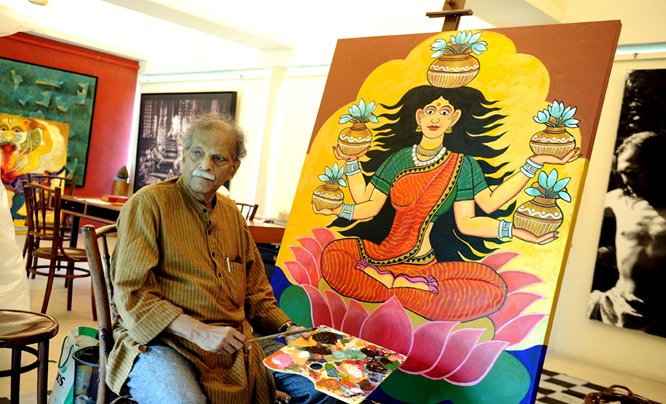 Preparing for exhibition at Kamaria, I'm from Ganjam, so are the Images (2015) Painting inspired by village temple murals Photo: A. Prathap By sheer coincidence, the culmination of his collaboration with Sutra came about only last July when Sutra premiered Amorous Delight based on the illustrated palmleaf publication of Amarushataka (9th century Sanskrit anthology), which Pathy had collaborated with Dr Eberhard Fischer. I had told Pathy when I first set eyes on the book (published by Rietberg Museum, 2006) that it had a great potential as a dance production. A collaboration with Gunjan dancer/choreographer Meera Das, Amorous Delight's Cuttack premiere was somewhat lost in flurry of other performances lumped together and for the lack of attention to detail. Pathy was unimpressed with the Cuttack presentation. However, for its Malaysian premiere, I was determined to give the production the careful staging that it needed. For the Malaysian premiere, Pathy worked doubly hard to bring out the most compelling images, which augmented and brought to life the lyrical and subtle eroticism of the production. What Pathy had experimented in GANJAM, he perfected in Amorous Delight. His compelling drawings, amplified on the large screen, was inspired by the palm leaf illustration of Amarushataka by the Sharanakula master. Peppered with his symbolist style, his projected images effortlessly blended with the choreography and became a triumph of theatre design. They were a sheer joy to watch. He was delighted with the effort and many in the audience came forward to congratulate him! 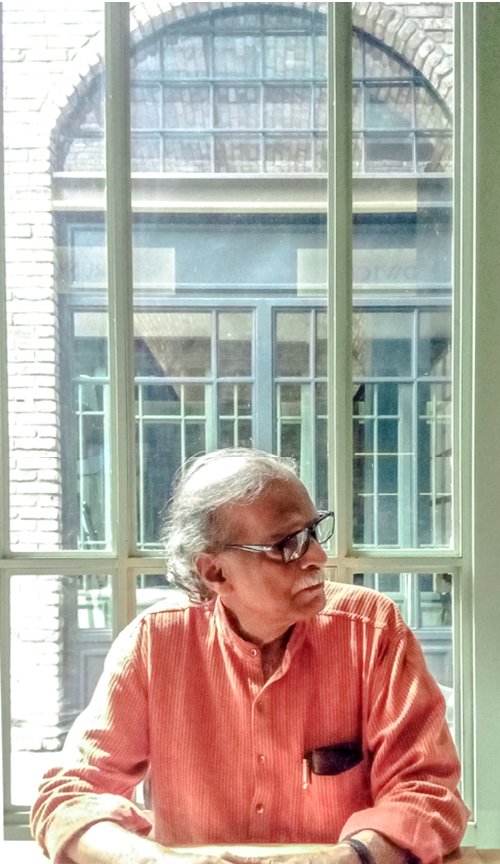 Dinanath Pathy, waiting for the performance of Amorous Delight Damansara Performing Arts Centre (2016) Photo: Abtin Javid 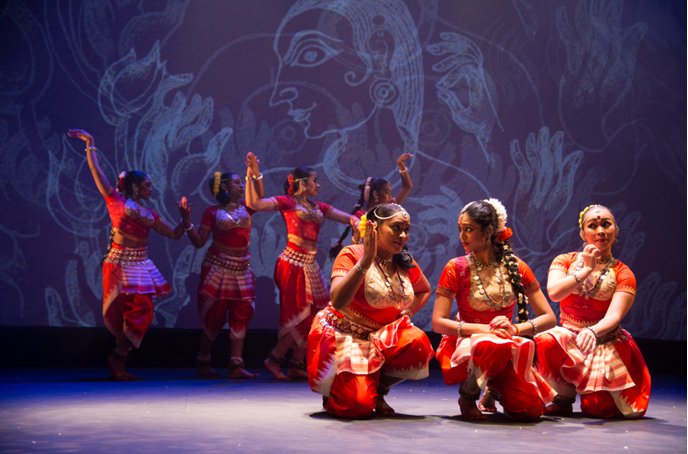 Sutra Dancers in Amorous Delight with background of drawing by Dinanath Pathy Photo: S. Magendran (2016) In conjunction with the production of Amorous Delight, Pathy also curated artist Jyotiranjan Swain's first painting exhibition at Kamaria/Sutra Gallery. True to form (just as he had inspired and pushed countless other artists of Odisha to explore and reveal their gift), Pathy was instrumental in convincing Jyotiranjan, who is Odisha well known graphic art-director, to also explore his potential as a visual artist. Pathy, the talent cultivator, who recognised a potential when he saw one, hated to see it go waste. He had equally persuaded and convinced other artists such as Dr JP Das, Jagannath Panda, Dilip Tripathy, Lekshashri Samantsinghar and many others to heed their artistic calling. They had benefited from his prodding. As for Jyotiranjan, his exhibition at Sutra would be etched as a triumphant affirmation of his visual art talent. Indisputably, Pathy had become a renaissance man of Odisha who tried his damnest to change whatever archaic mindset amongst his people. A man whose life can only be described as 'epic', one who had conceived so many artistic ventures and undertakings, it would be impossible to say it all in this brief tribute to the late Dr Dinanath Pathy. The essay could only discuss a Sutra perspective of his artistic involvement. Pathy remained one of the most artistically satisfying collaborators Sutra had ever the privilege to work with. We had, over the years, been through many challenges sharing the joys and tribulations of the fruits of our collaboration from literature, music to the performing and visual arts. He had contributed much to the content of Sutra's literature, acting as adviser and consultant to a substantial body of our projects. Both of us knew fully well that no art form can move forward without the augmentation of a strong body of literature to communicate to the larger public its message and manifesto. Pathy's depth of knowledge coupled with his visionary insight to the possible destiny of the subject, such as Odissi or the indigenous crafts he was involved in, sometimes made him appear impatient, argumentative and eventually, towards the end part of his life, out of place, out of time with his more bureaucratic peers. He had to deal with, not only the powerful, but the crassly commercialized and simple-minded, whilst he was a sensitive artist-oracle, with an uncanny insight of the fate that would befall his subject. He was also exasperated with the general run-of-the-mill academics, who were stuck within the four walls of their offices and out of touch with the spirit of the land. He valued original ideas whilst 'they' were mere followers of contemporary trends and fashion. He built institutions only to become the builder betrayed when he found that his concepts misappropriated and eventually jettisoned to make way for the crass and vulgar. 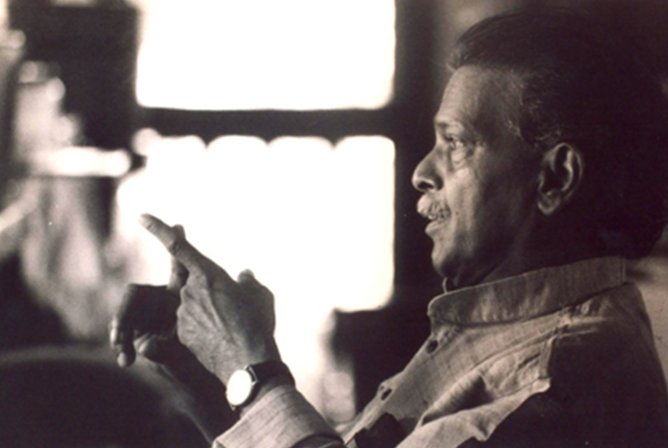 Dinanath Pathy at Sutra House. Photo: Sivarajah Natarajan (2008) Pathy, the avant-garde modernist, was acutely in love with the authentically traditional. He saw through the danger of exoticising and appropriating traditional objects and practices for commercial agendas. He loved the diversity of cultures, which had flourished in Odisha. For instance, he was concerned and foreshadowed the dismal fate of the diverse traditional performing arts of the rest of Odisha in the wake of the instant gratification of commercialism. For Pathy, 'popular' Odissi had been diluted, uniformised and became boring especially those featured in the numerous touristic festivals that now plagued Odisha. It had 'sold' out its soul and lost its essential authenticity, the price it had dearly paid for its fame. Its hegemonic popularity posed a danger to the less known indigenous dance forms. "Everyone wants to learn Odissi, even in small towns of Odisha. Nobody wants to do his own dance anymore. Odissi has become the juggernaut that tramples over everything under its wake! What these young kids learn is not even good Odissi! Even the gotipuas will forgo their earthy style and eventually be sanitised Odissi dancers," he lamented. Ramli Ibrahim is the founder and artistic director of Sutra Foundation, Malaysia. Comments What a beautiful article on Dinanath! The proper tribute from one who has moved so closely with him for so many years. I am happy that Ramli Ibrahim has sent such a warm tribute to the man with whom he shared a very special bond. - Leela Venkataraman (Sept 13, 2016) Post your comments Please provide your name and email id along with your comment. All appropriate comments posted with name and email id in the blog will also be featured in the site. |